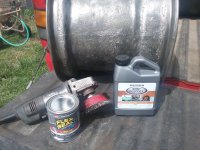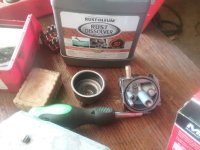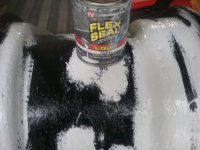RedMF40
Well-known Member
This idea for de-rusting metal parts involves a cement mixer, some sand and pea gravel and maybe a little water. You probably know where I’m going with this.
 After soaking some heavily-rusted parts in a vinegar bath for about a week, most of the rust is pretty well dissolved. Just remains a thin surface layer that can be wire-wheeled off if I had about 300 hours to kill. My objective is to get the parts to where they can be painted.
After soaking some heavily-rusted parts in a vinegar bath for about a week, most of the rust is pretty well dissolved. Just remains a thin surface layer that can be wire-wheeled off if I had about 300 hours to kill. My objective is to get the parts to where they can be painted.
I thought about those rock tumblers that people use to polish rocks. Why not apply the same thinking to metal parts? Put a mix of sand and rocks and water together, toss the parts into the cement mixer, and go have a sandwich. Or maybe check in next day. Or the day after.
I know there is probably something I’m not taking into account, so let me know why this idea will or won’t work if you don’t mind. Will it set the whole mixer to vibrating horribly—sending people fleeing in terror? I’m aware the operation will make a racket, but I can just leave it alone in my workshop—maybe it’ll convince the critters who live there that’s it’s time to move to a quieter neighborhood.
Since I know that I’m just one of many crackpots dreaming up labor-saving ideas, I’m sure that someone—somewhere—has tried this.
I welcome any thoughts before I go out and buy a second-hand cement mixer.
Gerrit
I thought about those rock tumblers that people use to polish rocks. Why not apply the same thinking to metal parts? Put a mix of sand and rocks and water together, toss the parts into the cement mixer, and go have a sandwich. Or maybe check in next day. Or the day after.
I know there is probably something I’m not taking into account, so let me know why this idea will or won’t work if you don’t mind. Will it set the whole mixer to vibrating horribly—sending people fleeing in terror? I’m aware the operation will make a racket, but I can just leave it alone in my workshop—maybe it’ll convince the critters who live there that’s it’s time to move to a quieter neighborhood.
Since I know that I’m just one of many crackpots dreaming up labor-saving ideas, I’m sure that someone—somewhere—has tried this.
I welcome any thoughts before I go out and buy a second-hand cement mixer.
Gerrit






